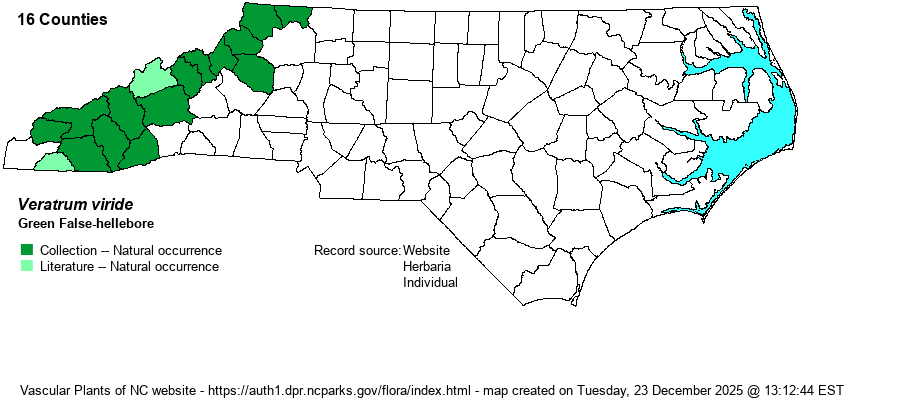| Author | Aiton | |
| Distribution | Strictly in the Mountains, where presumably found in all counties, though lacking verified records for several of them.
This is a Northern species, found across much of Canada and south to NJ and PA, and then through the Appalachian Mountains to northern GA. It generally is not found in the Great Lakes states. | |
| Abundance | Fairly common to locally frequent in most of the Mountains, most often seen in mid-elevations and not numerous at the lower ones (below 2500 feet in elevation). | |
| Habitat | This species favors damp, shaded places, especially along seepages through rich hardwood forests, including Rich Cove Forests and Northern Hardwood Forests. It can be found in montane bottomlands, along damp streambanks, and wet boulderfields, as long as the plants are shaded. |
| Phenology | Blooms from June into August, and fruits from July to September. | |
| Identification | This is a very robust herbaceous species, easily catching the eye of someone walking through a cove forest or other cool, montane forest. The plant has a broad stem that reaches 2-3 feet tall, beset with numerous, very large alternate leaves that clasp the stem. Each leaf is broadly elliptic and about 8-9 inches long and about 4-5 inches wide, among the largest leaves someone will find on an herbaceous plant. Leaves are strongly veined, even pleated, lengthwise. Immediately above the top leaf is the large "panicled" inflorescence, often 1 foot tall, consisting of dozens of fairly large greenish flowers, each nearly 1 inch across. However, because the flowers are about the same color as the stem and leaves, your eyes are not drawn to the top of the stem (as they are to other lilies with white flowers). Nonetheless, you do not need the flowers to identify the species, as only the rather rare Yellow Lady's-slipper (Cypripedium parviflorum) has such large, clasping leaves. The orchid typically has fewer leaves, often just a few of them, and thus does not appear as leafy; however, it blooms in the spring and has a completely different flower, if one is lucky to catch a fertile individual. Veratrum viride is a characteristic species of forested seepages in our mountains, easily spotted from a long distance owing to its robust size and large leaves. | |
| Taxonomic Comments | None for our area, but some references consider this species as ranging to the Pacific Coast, as shown on the BONAP map. Weakley (2018) considers that Western form as being a separate species -- V. eschscholtzii.
| |
| Other Common Name(s) | White Hellebore, Indian Poke, Green Hellebore, Cornhusk Lily, Corn-lily, Giant False-hellebore | |
| State Rank | S4 | |
| Global Rank | G5 | |
| State Status | | |
| US Status | | |
| USACE-agcp | FAC link |
| USACE-emp | FACW link |

